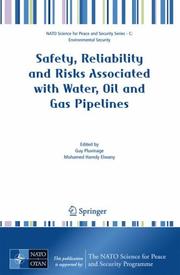| Listing 1 - 3 of 3 |
Sort by
|
Digital
ISBN: 9781402065262 Year: 2008 Publisher: Dordrecht Springer
Abstract | Keywords | Export | Availability | Bookmark
 Loading...
Loading...Choose an application
- Reference Manager
- EndNote
- RefWorks (Direct export to RefWorks)

ISBN: 9781402065248 9781402065262 1402065248 9781402065255 1402065256 9786611138219 1281138215 1402065264 Year: 2008 Publisher: Dordrecht Springer Netherlands
Abstract | Keywords | Export | Availability | Bookmark
 Loading...
Loading...Choose an application
- Reference Manager
- EndNote
- RefWorks (Direct export to RefWorks)
Pipes are of major importance for transport of liquids and gas mainly for water, natural gas and oil. The total length of gas pipes in the world is estimated at one million kilometres for gas transport (pipes with a diameter of 80 to 1000 mm). Pipelines remain the least expensive transcontinental mean of transport compared to rail-bound or terrestrial transport. It has become increasingly paramount to ensure the safe utilisation of such plant in order to prevent economical, social and ecological losses. From a technical point of view, pipelines are complicated three dimensional structures that include straight pipes, nozzles, pipe-bends, dissimilar welded joints, etc. In addition, their operating conditions can be quite severe, that is, internal pressure and cyclic loading (vibration) combined with the influence of internal and external corrosive environments. The external defects, e.g., corrosion defects, gouge, foreign object scratches, and pipeline erection activities are major failure reasons of gas pipelines. All these types of defects and associated failure are described. Leak and fracture of pipes is assumed to be done by initiation and propagation of defect and final failure when defect has reached a critical length. In this book, the three two major defect assessment tools for pipes are presented : i) the failure assessment diagram and particularly the SINTAP procedure, ii) limit analysis, iii) strain design approach Methods of defect repair are based on investigation findings. Methods such as welded sleeve, repair clamp composite sleeve, grinding, pipe replacement are described.
Pipelines --- Defects --- Maintenance and repair
Book
ISBN: 1281138215 9786611138219 1402065264 Year: 2008 Publisher: Dordrecht, Netherlands : Springer,
Abstract | Keywords | Export | Availability | Bookmark
 Loading...
Loading...Choose an application
- Reference Manager
- EndNote
- RefWorks (Direct export to RefWorks)
Pipes are of major importance for transport of liquids and gas mainly for water, natural gas and oil. The total length of gas pipes in the world is estimated at one million kilometres for gas transport (pipes with a diameter of 80 to 1000 mm). Pipelines remain the least expensive transcontinental mean of transport compared to rail-bound or terrestrial transport. It has become increasingly paramount to ensure the safe utilisation of such plant in order to prevent economical, social and ecological losses. From a technical point of view, pipelines are complicated three dimensional structures that include straight pipes, nozzles, pipe-bends, dissimilar welded joints, etc. In addition, their operating conditions can be quite severe, that is, internal pressure and cyclic loading (vibration) combined with the influence of internal and external corrosive environments. The external defects, e.g., corrosion defects, gouge, foreign object scratches, and pipeline erection activities are major failure reasons of gas pipelines. All these types of defects and associated failure are described. Leak and fracture of pipes is assumed to be done by initiation and propagation of defect and final failure when defect has reached a critical length. In this book, the three two major defect assessment tools for pipes are presented : i) the failure assessment diagram and particularly the SINTAP procedure, ii) limit analysis, iii) strain design approach Methods of defect repair are based on investigation findings. Methods such as welded sleeve, repair clamp composite sleeve, grinding, pipe replacement are described.
Pipelines. --- Pipelines --- Reliability. --- Safety measures. --- Pipe lines --- Hydraulic structures --- Transportation --- Materials. --- Mechanical engineering. --- Engineering design. --- System safety. --- Materials Science, general. --- Water Industry/Water Technologies. --- Mechanical Engineering. --- Engineering Design. --- Quality Control, Reliability, Safety and Risk. --- Engineering --- Engineering materials --- Industrial materials --- Engineering design --- Manufacturing processes --- Safety, System --- Safety of systems --- Systems safety --- Accidents --- Industrial safety --- Systems engineering --- Design, Engineering --- Industrial design --- Strains and stresses --- Engineering, Mechanical --- Machinery --- Steam engineering --- Materials --- Prevention --- Design --- Materials science. --- Water-supply. --- Quality control. --- Industrial safety. --- Industrial accidents --- Industries --- Job safety --- Occupational hazards, Prevention of --- Occupational health and safety --- Occupational safety and health --- Prevention of industrial accidents --- Prevention of occupational hazards --- Safety, Industrial --- Safety engineering --- Safety measures --- Safety of workers --- System safety --- Dependability --- Trustworthiness --- Conduct of life --- Factory management --- Industrial engineering --- Reliability (Engineering) --- Sampling (Statistics) --- Standardization --- Quality assurance --- Quality of products --- Availability, Water --- Water availability --- Water resources --- Natural resources --- Public utilities --- Water resources development --- Water utilities --- Material science --- Physical sciences
| Listing 1 - 3 of 3 |
Sort by
|

 Search
Search Feedback
Feedback About UniCat
About UniCat  Help
Help News
News